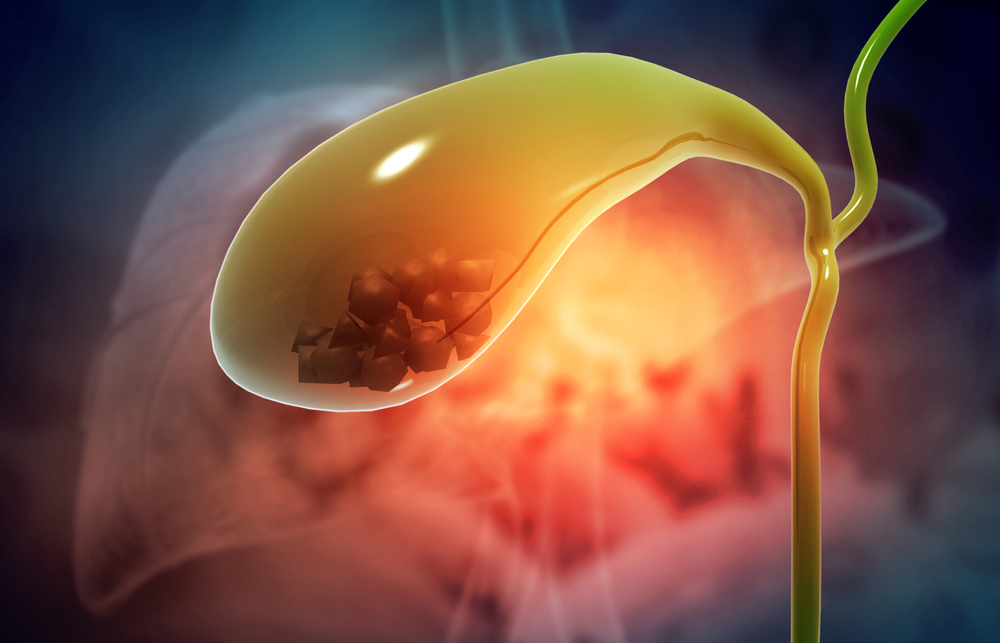Gallstones are formed in the gallbladder, which is an organ located below the liver in the upper right abdomen. The gallbladder is a small, sack-like structure that stores bile, a greenish liquid that aids digestion.
Gallstones can present as single stones or in numerous numbers and can be of differing sizes, they can be as small as a grain of sand or as big as a ping-pong ball.
Whether a patient requires surgery depends on the symptoms. If a patient experiences symptoms of pain, surgery might be necessary to remove the gallstones. On the other hand, asymptomatic patients usually do not require surgical intervention.
Types of gallstones
Gallstones are formed by the hardening of the following substances in the body:
- Cholesterol is formed from fatty substances in the blood and causes the formation of the most common kinds of gallstones. These are usually yellow.
- Pigment stones are mainly composed of bilirubin. Bilirubin is formed when red blood cells are broken down by the liver. An excess of bilirubin in the blood can cause yellowing of the skin and eyes (jaundice). These gallstones are generally dark brown or black.
Why do you get gallstones?
Although it is not clear how gallstones are formed, they may form in the following instances:
- An excess of cholesterol in the bile, which the liver is unable to liquify
- An excess of bilirubin which can result from medical conditions, such as liver cirrhosis, infections of the biliary tract, and some blood disorders
Risk Factors for Getting gallstones
These are some instances that increase the occurrence of gallstone formation:
- Family history of gallstones
- Females
- Over 40 years of age
- Overweight
- A diet rich in fat and cholesterol and low in fibre
- Not exercising regularly
- Pregnancy
- Diabetes
- Blood disorders such as haemolytic anaemia
- Liver cirrhosis
- Fasting regularly
Signs and symptoms of gallstones
The majority of people who have gallstones are asymptomatic. The symptoms experienced in some patients depend on the size of the gallstone and usually develop if the gallstone causes an obstruction. Symptoms caused by the obstructions can include:
- Instant and severe pain on the upper right abdomen or in the middle of the abdomen
- Nausea and vomiting
- Pain in the right shoulder
If left untreated, they may cause serious infections and result in symptoms such as:
- Constant severe pain in the abdomen
- High fever
- Yellowing of the skins and eyes
- Black urine and light-coloured stool
If you experience any of the above mentioned signs or symptoms consult a doctor or go to the hospital immediately.
Diagnosis
A physician can diagnose gallstones by taking a thorough patient medical history and performing a complete physical examination. In addition, some diagnostic tests include:
- Abdominal ultrasounds are an accurate diagnostic tool that enable a physician to visually detect any signs of gallstones
- Blood tests are done to check for infections, jaundice, pancreatitis, or other complications arising from gallstones
- Imaging tests such as a hepatobiliary iminodiacetic acid (HIDA) scan, computerised tomography (CT) scan, magnetic resonance cholangiopancreatography (MRCP) and endoscopic retrograde cholangiopancreatography (ERCP) are done if an abdominal ultrasound does not identify gallstones
Complications
Some complications associated with gallstones include:
- Inflammation of the gallbladder (cholecystitis), which can present as severe pain in the abdomen and a fever
- Obstruction of the common bile duct, which can present as severe pain, fever, and an infection
- Obstruction of the pancreatic duct results in issues related to digestion as pancreatic secretions are not able to enter the small intestine.
- Although rare, gallstones may lead to an increased incidence of gallbladder cancer
Treatments for gallstones
Natural treatment and home remedies
Supplements such as vitamin C, iron or lecithin decrease the incidence of gallstones. Maintaining a healthy lifestyle and diet is also essential in preventing their formation.
Surgical treatment
Surgical therapy may not be necessary in asymptomatic patients and small gallstones are able to pass from the body without presenting any signs.
In the event that a patient develops severe symptoms or gets complications, surgical intervention, or a cholecystectomy, may be recommended to remove the gallbladder.
There are two types of surgical intervention:
1. Laparoscopic cholecystectomy
This is the most commonly used technique to remove the gallbladder. In this procedure, the surgeon makes a small abdominal incision and inserts a tube called a laparoscope, to remove the gallbladder. The patient is usually sent home on the same day as the procedure.
2. Open cholecystectomy
This involves making larger incisions in the abdomen to remove the gallbladder, following which the patient is admitted to the hospital for a few days.
If a gallstone is lodged in the bile ducts, surgeons conduct an ERCP to look for the stones and take them out either before or during surgery.
Medication
If surgical intervention is not possible, the patient may be treated with medication. However, medication may take years to eliminate the gallstones. Additionally, ceasing medication might result in the recurrence of gallstone formation, eventually resulting in the need for surgical intervention.
How to prevent gallstones?
The following are some helpful tips to reduce the possibility of developing gallstones:
- Not skipping meals and avoiding fasting for prolonged periods
- Avoiding rapid weight loss
- Eating foods rich in fibre such as vegetables, fruits, and whole grains
- Maintaining a healthy body mass
- Exercising regularly
- Avoiding foods that are full of fats or cholesterol
- Drinking plenty of water












